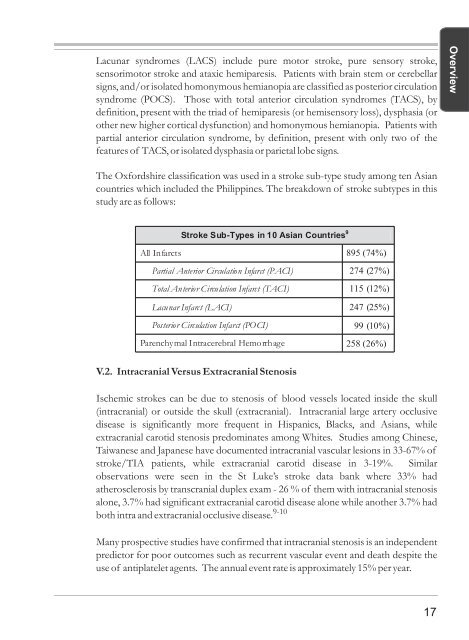Front Panel Painting “LIFE” By William T Chua MD
FREE download - Stroke Society of the Philippines
FREE download - Stroke Society of the Philippines
Create successful ePaper yourself
Turn your PDF publications into a flip-book with our unique Google optimized e-Paper software.
Lacunar syndromes (LACS) include pure motor stroke, pure sensory stroke,<br />
sensorimotor stroke and ataxic hemiparesis. Patients with brain stem or cerebellar<br />
signs, and/or isolated homonymous hemianopia are classified as posterior circulation<br />
syndrome (POCS). Those with total anterior circulation syndromes (TACS), by<br />
definition, present with the triad of hemiparesis (or hemisensory loss), dysphasia (or<br />
other new higher cortical dysfunction) and homonymous hemianopia. Patients with<br />
partial anterior circulation syndrome, by definition, present with only two of the<br />
features of TACS, or isolated dysphasia or parietal lobe signs.<br />
Overview<br />
The Oxfordshire classification was used in a stroke sub-type study among ten Asian<br />
countries which included the Philippines. The breakdown of stroke subtypes in this<br />
study are as follows:<br />
Stroke Sub-Types in 10 Asian Countries 9<br />
All Infarcts 895 (74%)<br />
Partial Anterior Circulation Infarct (PACI) 274 (27%)<br />
Total Anterior Circulation Infarct (TACI) 115 (12%)<br />
Lacunar Infarct (LACI) 247 (25%)<br />
Posterior Circulation Infarct (POCI) 99 (10%)<br />
Parenchymal Intracerebral Hemorrhage 258 (26%)<br />
V.2. Intracranial Versus Extracranial Stenosis<br />
Ischemic strokes can be due to stenosis of blood vessels located inside the skull<br />
(intracranial) or outside the skull (extracranial). Intracranial large artery occlusive<br />
disease is significantly more frequent in Hispanics, Blacks, and Asians, while<br />
extracranial carotid stenosis predominates among Whites. Studies among Chinese,<br />
Taiwanese and Japanese have documented intracranial vascular lesions in 33-67% of<br />
stroke/TIA patients, while extracranial carotid disease in 3-19%. Similar<br />
observations were seen in the St Luke’s stroke data bank where 33% had<br />
atherosclerosis by transcranial duplex exam - 26 % of them with intracranial stenosis<br />
alone, 3.7% had significant extracranial carotid disease alone while another 3.7% had<br />
both intra and extracranial occlusive disease. 9-10<br />
Many prospective studies have confirmed that intracranial stenosis is an independent<br />
predictor for poor outcomes such as recurrent vascular event and death despite the<br />
use of antiplatelet agents. The annual event rate is approximately 15% per year.<br />
17



